#neoceratodus forsteri
Text

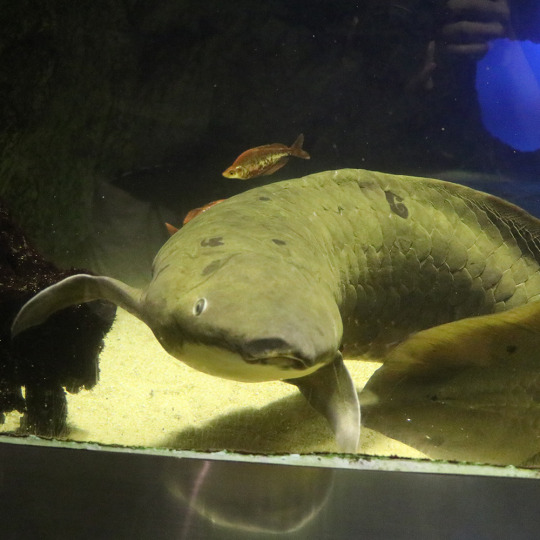
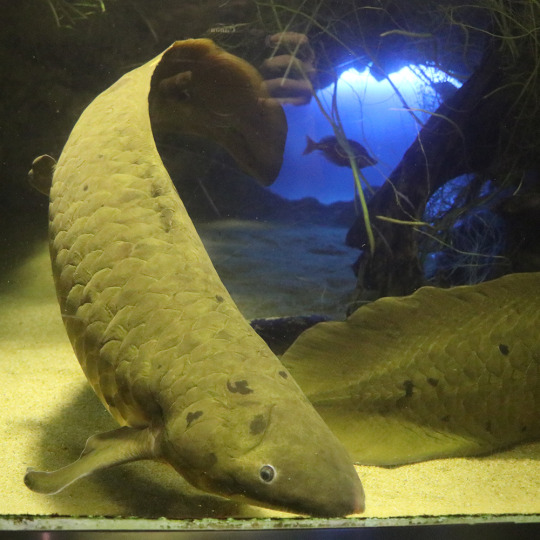
呼吸してるところも見られた
でもいつも撮れないんだよなぁ
興奮しすぎてるのかもしれないです
@鳥羽水族館
I could see them breathing, but I can't always capture it. I might be too excited....
@Toba Aquarium
#neoceratodus forsteri#ネオケラトドゥスフォルステリ#ネオケラトドゥス・フォルステリ#オーストラリアハイギョ#lungfish#Australian lungfish#fish#freshwater fish#鳥羽水族館
2K notes
·
View notes
Text

Lungfish sketch :) trying a new brush
#mostly I like the brush but it's very... not quite blurry but kind of shaky#astigmatism simulator 😔#lungfish#fish#lobe finned fish#fish art#aquatic#sarcopterygii#neoceratodus forsteri
118 notes
·
View notes
Text
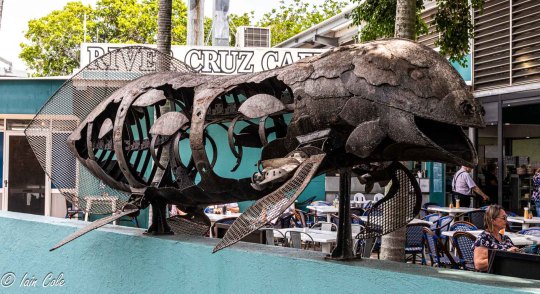
Lungfish sculpture, Bundaberg
The Australian Lungfish (Neoceratodus forsteri) is the oldest known living vertebrate species. It has a long heavily scaled body, a wide flat head and lobed, paddle-shaped fins. It is the most primitive member of the six lungfish species that survive today, and the only species in the family Ceratodontidae.
Lungfishes belong to an ancient lineage of air-breathing fishes that first appeared in the fossil record about 380 million years ago and were common during the Devonian Period.
19 notes
·
View notes
Text


Have I made it clear yet that I like fish
#Australian lungfish#neoceratodus forsteri#evanesce art#oc art#Butter#Aussie lungfish and severums are my favourite species
6 notes
·
View notes
Text

World's oldest aquarium fish 'Methuselah' could be decades older than we originally thought, DNA clock reveals
A new study has found that the famous Australian lungfish Methuselah, who first arrived in the U.S. in 1938, could be up to 101 years old.
The world's oldest aquarium fish, a lungfish named Methuselah, may actually be decades older than researchers originally thought and may even be over 100 years old, a new study finds.
Methuselah is a female Australian lungfish (Neoceratodus forsteri) that resides at Steinhart Aquarium in San Francisco, California. She first arrived at the aquarium in 1938 after being sent to the U.S. along with more than 200 other fish from Fiji and Australia.
Aquarium staff have never been sure how old Methuselah is, but until now the best guess was that she is 84 years old, which makes her the oldest known fish in captivity. (In the Bible, Methuselah was a man who reputedly lived to be 969 years old.)...
Read more:
World's oldest aquarium fish 'Methuselah' could be decades older than we originally thought, DNA clock reveals | Live Science
5K notes
·
View notes
Photo

when I first got procreate, I tested it out by idly painting this giant lungfish! it’s an australian lungfish (neoceratodus forsteri). I like their faces :]
57 notes
·
View notes
Text

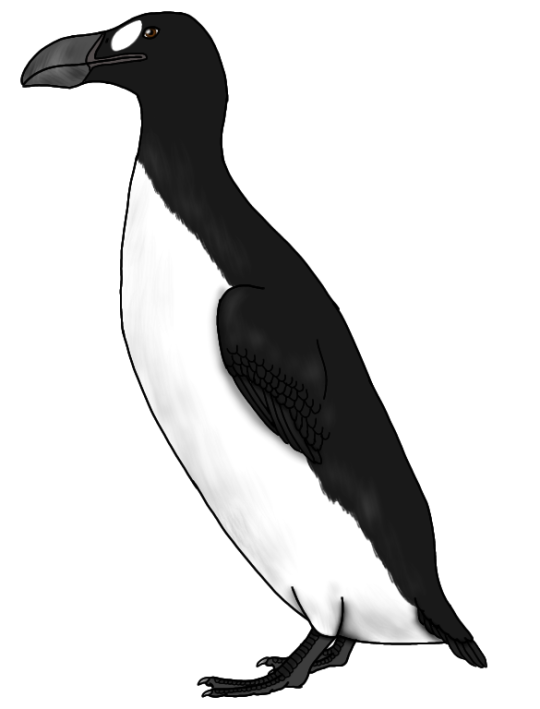
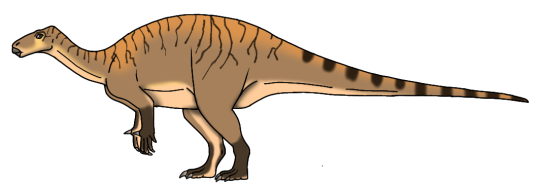






1. Ceratops montanus
2. Pinguinus impennis (Great Auk)
3. Hippodraco scutodens
4. Sinodraco viridis (Green Qinglong)
5. Engraulis mordax (Californian Anchovy)
6. Lurdusaurus arenatus
7. Navajoceratops sullivani (Dolanagesitsin)
8. Chondrocladia lampadiglobus (ping pong tree sponge)
9. Neoceratodus forsteri (Australian Lungfish)
#ognimdo2002#earth responsibly#science fantasy#rapunzel's tangled adventure#great auk#bird#australian lungfish
2 notes
·
View notes
Text
What monster fish are you?

Australian Lungfish (Neoceratodus forsteri)
You're a gentle person who carries their heart on their sleeve. You openly and unashamedly let people lean on you, and you enjoy being a shoulder to cry on for your friends and family. Because of your innate desire to be helpful and lack of hesitancy to be vulnerable with others, some people might take advantage of your kindness. Consistency and loyalty are good traits to have, but don't be afraid to put your own needs first every once in a while.
tagged by: @simiansmoke thankies :3
tagging: u
1 note
·
View note
Link

Un articolo pubblicato sulla rivista "Science Advances" riporta uno studio su pesci della specie Neoceratodus forsteri che offre nuove informazioni sull'evoluzione delle pinne dei pesci negli arti dei tetrapodi. Un team di ricercatori guidato dal dottor Joost Woltering dell'Università tedesca di Costanza ha studiato in particolare le caratteristiche anatomiche e genetiche di embrioni di Neoceratodus forsteri. Il risultato è stata la conferma dell'importanza di alcuni geni con nuove informazioni sui geni coinvolti e la scoperta di una mano primitiva nelle pinne di questo pesce, che suggerisce un'evoluzione degli arti con dita attraverso cambiamenti embrionali.
2 notes
·
View notes
Link
A group of scientists at the Research Institute of Molecular Pathology in Austria has broken a new record for sequencing the largest animal genome to date – the endangered, air-breathing, Australian lungfish (Neoceratodus forsteri). This lungfish is one of the few living relatives of the first land vertebrates. Its genome...
37 notes
·
View notes
Text
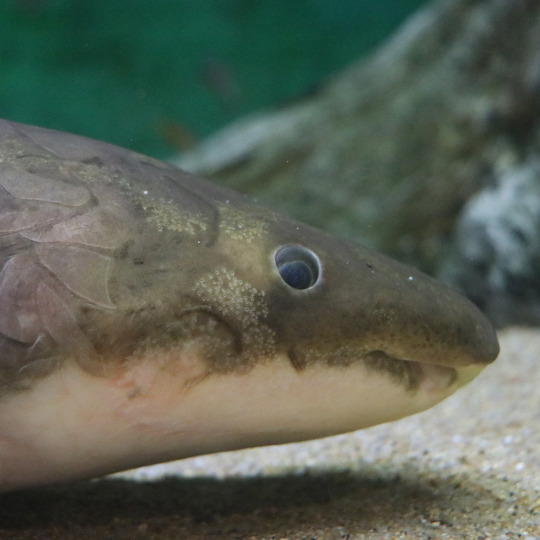
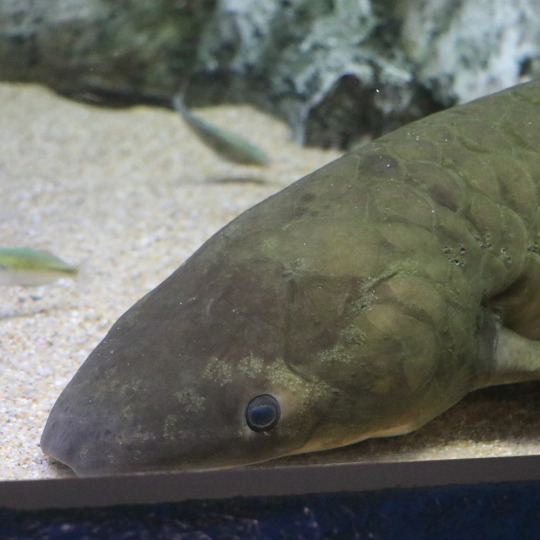
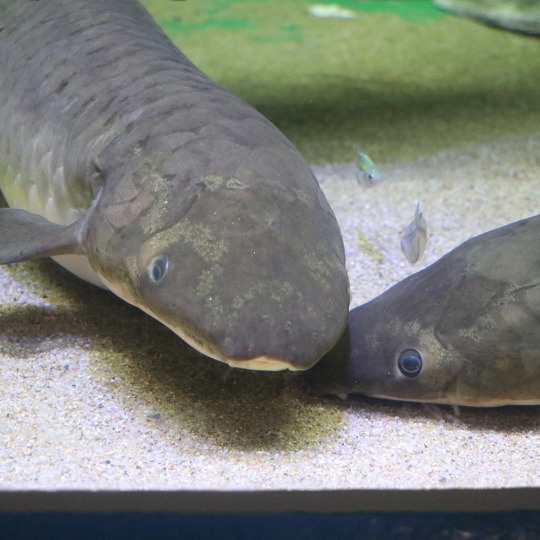
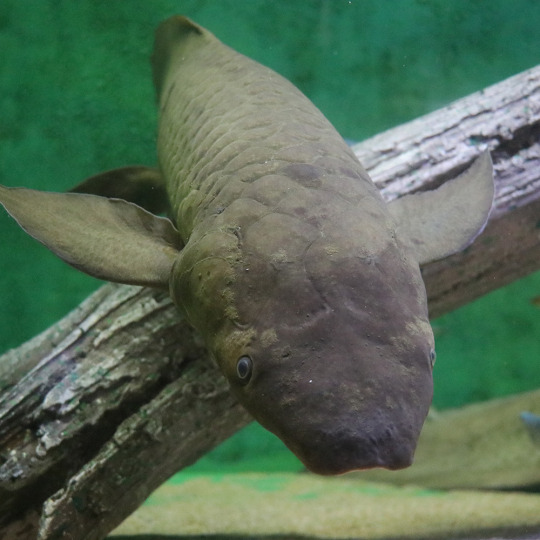
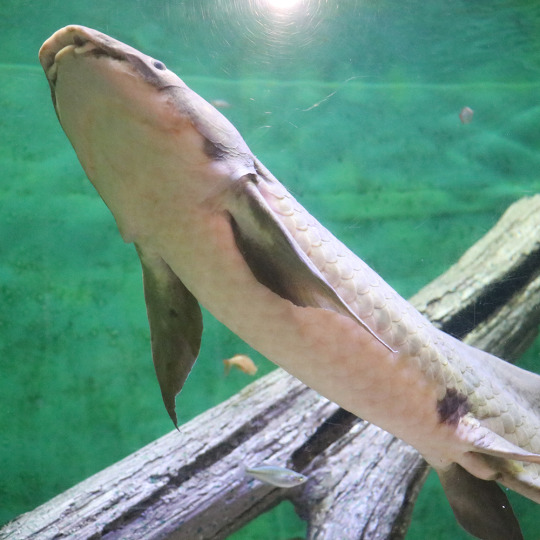
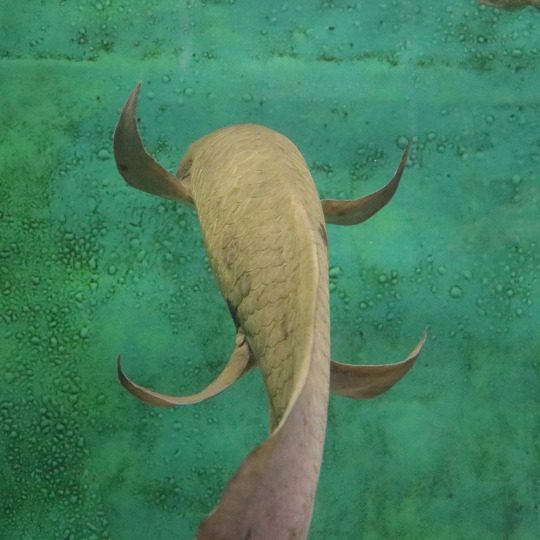
竹島水族館は彼らが見やすくてサイコーだぁああ
@竹島水族館
Takeshima Aquarium is fantastic for easy viewing of these creatures!!!!!!!!!!!!!!!!!!!!!!
@Takeshima Aquarium
#竹島水族館#freshwater fish#fish#neoceratodus forsteri#lungfish#australian lungfish#オーストラリアハイギョ#ネオケラトドゥスフォルステリ#ネオケラトドゥス・フォルステリ
371 notes
·
View notes
Text
apparently the australian lungfish neoceratodus forsteri is older than the entire continent of australia and i haven’t been okay since i learned this
#i want to be very clear that it is not just the genus or clade or lineage that is older than the 96 million year old continent of australia#but the same exact species that is still swimming around to this day#they haven't changed at all in 100 million years at least#they're probably the oldest vertebrate species on the planet and one of the longest lived species ever#how does this animal exist#how do we all just go about life like the world isnt utterly cursed and beautiful when creatures that predate trex#are just out here swimming in rivers and eating worms like it's no big deal#also#they're endangered bc humans keep damming up the few rivers where they live and breed#so they've been alive longer than entire fucking continents and they're gonna go extinct because of humans#i love existing during a mass extinction
7 notes
·
View notes
Text
Headcanon (sort of)
Lungfish are native to Australia, Africa, and South America (three different families, taxonomy-wise). They don’t naturally occur in North America, where Whispering Rock is presumably located, meaning they were probably introduced to Lake Oblongata at some point in the past. Why? Who knows, maybe it was an accident.
Also, if you wanna get even more technical, Linda (in her original, un-mutated form) most closely resembles the Australian lungfish (Neoceratodus forsteri, top photo), which has bigger fins, although her smooth skin is closer to the South American lungfish (Lepidosiren paradoxa, bottom photo).


#Whispering Rock Psychic Summer Camp#Lake Oblangata#The Hideous Hulking Lungfish of Lake Oblangata#Psychonauts#Linda#my headcanons#Here with the lore nobody asked for#Also it turns out it's very hard to find a decent photo of a South American lungfish#The more you know tm
14 notes
·
View notes
Text
The Massive Genome of the Lungfish May Explain How We Made The Leap to Land
https://sciencespies.com/nature/the-massive-genome-of-the-lungfish-may-explain-how-we-made-the-leap-to-land/
The Massive Genome of the Lungfish May Explain How We Made The Leap to Land
If you are a lucky species, you will stumble into random gene mutations that just happen to help you survive better – allowing you and your descendants to keep and build on the helpful traits they encode. As with anything involving luck, the more chances you take, the more chances you have of hitting the jackpot.
That’s what seems to have happened with our long-ago ancestors – the ones we share with still living lungfish. They struck enough genetic jackpots to allow them to climb out of the water and access the whole new world of land, around 420 million years ago.
In doing so, they became the ancestors of all land animals with backbones (tetrapods). Having a massive genome, like that found in modern lungfish, may have helped with this.
Researchers just sequenced the entire genome of the endangered Australian lungfish (Neoceratodus forsteri), which has the largest known animal genome. It is 14 times the size of ours.
This required new DNA sequencing techniques and masses of computing power, only now technically possible – to piece together a whopping 43 billion nucleotides (‘letters’ in the genetic code).
“When you look at it from a genomic perspective, [lungfish are] genomically halfway between a fish and a land-based vertebrate,” biologist Siegfried Schloissnig from the Research Institute of Molecular Pathology (IMP) in Austria told New Scientist.
Of six still living species of lungfish, four are African, one South American, and one Australian. They first appeared in the fossil record 400 million years ago.
The Australian species has retained the most ancestral features, and was mistakenly classed as an amphibian when first discovered, due to its bizarre mix of fish and newt features, including its weird, leg-like lobed fins. These strange in-between ‘living fossils’ can live up to 100 years.
Australian lungfish still appear to closely resemble the fossils of their 100-million-year-old (and now extinct) ancestral species that hauled themselves out of the water, eventually spawning mammals, birds, reptiles, and amphibians.
Its genome confirms that this air-gulping swimmer is our closest living fish relative, beating the other contender, coelacanths – another group of lobed finned fish.
So within the Australian lungfish’s giant haystack of genes are clues to how animals made the transition from aquatic to terrestrial.
“This… required a number of evolutionary innovations including airbreathing, limbs, posture, prevention of desiccation, nitrogen excretion, reproduction, and olfaction,” the researchers write in their paper.
They identified the same genes responsible for our embryonic lung development already present in the lungfish, as are our familiar ulna and radius arm bones, and the genes that encode them. Tetrapod limb patterning genes like hox-c13 and sal1 had never been seen before in fish.
“Such novelties might have predisposed the [lobe-finned fish] to conquer land demonstrating how the lungfish genome can contribute to better understanding of this major transition during vertebrate evolution,” the team write.
The researchers also found huge additions to the lungfish’s genes associated with smell – what would have been a new suite of sensors suitable to their ancestors’ new environment. These genes code for receptors of airborne odours, while groups of receptors for waterborne scents shrunk.
Many of the excess genes that bulk out their hefty genome arose through copied sections of their DNA. Some of the lungfish’s individual chromosomes contain as many nucleotides as our entire human genome.
This form of genome expansion, through copies, is known to be an important driving force of evolution, with evidence that it helps provide organisms with the ability to rapidly adapt to a changing environment.
The Australian lungfish is an incredible living record of our evolution, and after preserving this genetic history for so long, it’s now under threat by human activities altering the freshwater habitats it calls home.
The animal hunts for frogs, worms and snails, as well as munching on plants in the water. It usually relies on gills to breathe, but its single lung allows the lungfish to surface for fresh air when dry conditions reduce their watery environment, making it murky and stagnant.
“There is no doubt that the newly sequenced genome will unveil more of the secrets of this bizarre vertebrate in the future,” said IMP cellular geneticist Elly Tanaka.
“Not only can it teach us things about adaptations to life on land, but it may also explain how certain genomes evolve to be so big.”
This research was published in Nature.
#Nature
#01-2021 Science News#2020 Science News#Earth Environment#earth science#Environment and Nature#Nature Science#News Science Spies#Our Nature#outrageous acts of science#planetary science#Science#Science Channel#science documentary#Science News#Science Spies#Science Spies News#Space Physics & Nature#Space Science#Nature
3 notes
·
View notes
Video
youtube
El pez pulmonado australiano (Neoceratodus forsteri) Ficha Técnica
2 notes
·
View notes
Photo

Kittenfish Genera
Kingdom: Animalia
Phylum: Chordata
Class: Sarcopterygii
Clade: Dipnomorpha
Subclass: Dipnoi
Order: Hemiamphibia
Family: Various (see below)
Ancestral species: Neoceratodus forsteri (Queensland lungfish)
Time period: early Lithocene to ? (65 million years to ? million years in the future [we have no idea how far into the future this genera survives because we have only gone to a maximum of 140 million years in the future]).
Information: the Kittenfish are a hardy genera of primarily-herbivorous and nocturnal fish. So hardy, in fact, that they have managed to survive two extinction-level events within a 30-million year span. Though they descend from lungfish, they have convergently evolved necks like their tetrapod cousins. Like their lungfish ancestors, they still have both lungs and gills, and can survive out of water for very long periods of time. Kittenfish have few teeth, and the only teeth they do have are small and rounded on the ends.
Shorttail Kittenfish (#1)
Kingdom: Animalia
Phylum: Chordata
Class: Sarcopterygii
Clade: Dipnomorpha
Subclass: Dipnoi
Order: Hemiamphibia
Family: Micropidae
Genus: Microps
Species: M. microcauda (”small-tailed small face”)
Ancestral species: Neoceratodus forsteri (Queensland lungfish)
Time period: late Lithocene to early Solocene (65 million years to 110 million years in the future).
Information: the Shorttail Kittenfish looks more like a dinosaur than a fish with its large sail and reptile-like head. This creature is about the size of a cleaner wrasse, and it feeds primarily on the bountiful algae and kelp around Occidensia’s beaches. They form large schools for safety when traveling in open water, though their small size and speed alone make them a hassle for any predator to try and catch, save for the dreaded Sea Albatross. It is also the earliest species of Kittenfish documented, with the earliest specimen found 65 million years in the future. The Shorttail Kittenfish is a dark green, perfect for blending in amongst its food source.
Longtail Kittenfish (#2)
Kingdom: Animalia
Phylum: Chordata
Class: Sarcopterygii
Clade: Dipnomorpha
Subclass: Dipnoi
Order: Hemiamphibia
Family: Micropidae
Genus: Microps
Species: M. macrocauda (”large-tailed small face”)
Ancestral species: Neoceratodus forsteri (Queensland lungfish)
Time period: early to late Solocene (105 million years to 135 million years in the future).
Information: a fast-moving nocturnal herbivore the size of a largemouth bass, the Longtail Kittenfish makes the kelp forests off the coast of Thalassia its home. They live under small rock crevices, but will also burrow themselves in the sand if necessary. It is a very-friendly animal to humans, showing no fear in approaching them. They also make good diving companions. It’s like a dog, but if it was a lungfish. And, if you ever need a quick food source, their meat tastes pretty-good (though, I’m not sure as to who would want to kill such an adorably puggish-looking animal). The Longtail Kittenfish is a bright yellow in color, which is perhaps a bit counterintuitive for avoiding predators.
Shellhead Kittenfish (#3)
Kingdom: Animalia
Phylum: Chordata
Class: Sarcopterygii
Clade: Dipnomorpha
Subclass: Dipnoi
Order: Hemiamphibia
Family: Ostracocephalidae
Genus: Ostracocephalus
Species: O. coelolophus (”hollow-crested shell-head)
Ancestral species: Neoceratodus forsteri (Queensland lungfish)
Time period: early Solocene (105 million years to 115 million years in the future).
Information: the Shellhead Kittenfish gets its name from the ossified fins on its head, which is uses as a means of communicating with one another. This animal is remarkable for both its size and coloration, being the largest member of the Kittenfish at a whopping 4 feet in length and its scales being an iridescent turquoise and its cephalic (head) fins being striped gold and green and having bright-red ovals in the middle. The oval shapes on the cephalic fins are bioluminescent, and the Shellhead Kittenfish can turn the glow on and off like a flashlight at its own free will. Like other Kittenfish, it is a nocturnal herbivore, and spends much of its time feeding on algae and aquatic plants around the Thalassian coast. It also makes a nice aquarium fish if you got a large-enough tank.
Flying Kittenfish (#4)
Kingdom: Animalia
Phylum: Chordata
Class: Sarcopterygii
Clade: Dipnomorpha
Subclass: Dipnoi
Order: Hemiamphibia
Family: Cyclocaudidae
Genus: Cyclocauda
Species: C. ichthyopteryx (”circle-tailed fish-wing”)
Ancestral species: Neoceratodus forsteri (Queensland lungfish)
Time period: late Nyctocene to early Solocene (95 million years to 107 million years in the future).
Information: filling the niche left by flying fishes, which died out approximately 2 million years before it, around 93 million years in the future, the Flying Kittenfish is a remarkable animal. The only member of its order that is capable of gliding, it lives across much of the world’s oceans, and feeds primarily on plankton and small crustaceans. They tend to form large schools in open ocean for safety. Also, they make a good food source. Just throwing that out there.
Reef Kittenfish (#5)
Kingdom: Animalia
Phylum: Chordata
Class: Sarcopterygii
Clade: Dipnomorpha
Subclass: Dipnoi
Order: Hemiamphibia
Family: Micropidae
Genus: Microps
Species: M. plesiominimus (”near-least small face”)
Ancestral species: Neoceratodus forsteri (Queensland lungfish)
Time period: early Solocene to ? (105 million years to ? million years in the future)
Information: living among the coral reefs off the coast of Thalassia, the Reef Kittenfish spends much of its eating algae off the coral. The size of a bluegill, the Reef Kittenfish is small, maneuverable, and fast. In coloration, it is violet. Hence, it also had the nickname of “the Violet Kittenfish”. They make small burrows in the sand, where they hide from predators. Overall, this animal is the hide-and-seek champion; it’s very difficult to spot once it’s buried in sand.
Dwarf Kittenfish (#6)
Kingdom: Animalia
Phylum: Chordata
Class: Sarcopterygii
Clade: Dipnomorpha
Subclass: Dipnoi
Order: Hemiamphibia
Family: Micropidae
Genus: Microps
Species: M. minimus (”least small-face”)
Ancestral species: Neoceratodus forsteri (Queensland lungfish)
Time period: late Nyctocene to early Solocene (95 million years to 110 million years in the future).
Information: at only the size of a minnow, the Dwarf Kittenfish is the smallest member of its order. Living in the coral reefs off the coast of Thalassia, the Dwarf Kittenfish shares a similar niche to its close relative, the Reef Kittenfish, in that it also eats algae off of coral. However, the Dwarf Kittenfish lives inside sea anemones, for which it has developed an immunity to their toxins. Its color is a vibrant pink.
5 notes
·
View notes